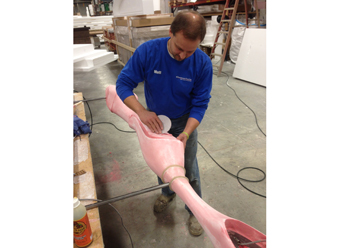Steve Avery, co-owner and chief designer at Avery Brothers Sign Company in Sioux City, Iowa, knows that the sign his company recently created for a local dental practice works. In addition to just simply looking at it, he can also tell because lots of parents are stopping by and taking pictures of their eager kids in front of it. “You know it works when kids love it,” he says proudly. “They’re not biased or influenced. They just know what they like.”
The dentists love it too and when it comes to their bright, new sign—a ten-foot-tall toothbrush attached to an electronic message center—they’re as eager to show it off as a patient who wants to flash his or her freshly cleaned pearly whites.
Drs. Kevin Lilly and his wife Jane operate Lilly Family Dentistry (also in Sioux City). They had doubled the size of their office and turned to Avery Brothers for a new sign. Over the years, Avery Brothers had made two other signs for them—first a sandblasted redwood sign with gold leaf lettering and then a similar design but featuring internal illumination—yet this time, Kevin wanted something more attention grabbing. His request: An illuminated sign of some type accompanied with an electronic message center.
But arriving at that “just right” design took some back-and-forth: Discussions with Avery and his then-Art Director Angie Kennedy lasted over eighteen months. “I have multiple files with multiple designs on this job,” says Avery. “Even though we’re trying to make money, we’re still going to do what the customer wants.”
Avery wasn’t particularly thrilled with Lilly’s last suggestion of just using a picture of a toothbrush on the sign. “I told him to at least let us make a large-size, three-dimensional prop of it instead,” he says, “and we could illuminate its bristles and make them change colors.
“This idea excited him, so we went out and bought a toothbrush at the grocery store and used it as a model to design this bigger one!”
For this project, Avery Brothers also created steel frame cabinets with aluminum skins, as well as backlit copy and the logo for Lilly Family Dentistry routed out of acrylic with vinyl overlays. The EMC is a 16mm resolution screen. “From the time [Lilly] came to us until the time we started, EMC resolutions had advanced from 19mm to much-higher 16mm,” says Avery. “So that was actually one good thing about the wait to build.”
Meanwhile Avery Brothers turned to Signs By Benchmark of Watertown, South Dakota to create the giant toothbrush. Avery Brothers had worked with Signs By Benchmark in the past (“Monkey Business,” January 2012), so they were already familiar with their capabilities in creating three-dimensional sign components. “Our team jumped at the chance to be involved in this project,” says Matt Frey, division manager at Signs By Benchmark. “We really like working with Avery Brothers. [They] have a way of designing one-of-a-kind sign projects where form follows function.”
 Signs by Benchmark fabricated the toothbrush from expanded polystyrene (EPS) cellular plastic. They began by importing the image of the giant toothbrush from the Adobe® Illustrator® file provided by Avery Brothers into AutoCAD to create the CNC cutting files. Benchmark then CNC-cut the toothbrush components, assembled them, and then hand-sanded the toothbrush to form the desired finished shape. The toothbrush was then cut in half in order to accept a steel armature.
Signs by Benchmark fabricated the toothbrush from expanded polystyrene (EPS) cellular plastic. They began by importing the image of the giant toothbrush from the Adobe® Illustrator® file provided by Avery Brothers into AutoCAD to create the CNC cutting files. Benchmark then CNC-cut the toothbrush components, assembled them, and then hand-sanded the toothbrush to form the desired finished shape. The toothbrush was then cut in half in order to accept a steel armature.
“We hand-assembled the parts around a steel armature we had made for additional support and for mounting provisions to the main sign,” explains Frey. “We then sandwiched the pieces back together and fully encapsulated it with our signature polyurea.”
Next Signs By Benchmark primed and finish-sanded the toothbrush to achieve a smooth, seamless shape. They then painted it with PPG basecoat/clear coat automotive paint.
For the illuminated bristles, the original idea was to use fiber optics. However Avery Brothers Fabricator/Installer Eric Lawson suggested LEDs instead. “This way, [Lilly] would have the ability to control colors—including different patterns,” says Avery. “And this would reduce the physical size of the actual wiring.”
There are forty-two bristles in this giant toothbrush (the same as the smaller one Avery purchased), and each 1-1/4-inch opening in its acrylic base has its own RGB LED cluster.
Avery Brothers attached the LED modules for the bristles to a 1/8-inch aluminum plate that acts as a solid mounting platform. “It also provided a very efficient heat sink for the LED modules themselves,” says Avery. (Note: Signs by Benchmark drilled mounting holes for the plate inside the structure of the toothbrush head before sending it back.)
{2j_imageviewer 41}
Watertight gaskets were added to a lip above the modules, after which the “bristle plate” was set flush to the surface. “The ‘bristle plate’ consists of 3/4-inch UV-resistant acrylic routed with forty-two one-inch-diameter holes,” says Avery. “We then glued 1/8-inch UV-resistant acrylic rods into these holes.”
Avery Brothers used digital point control LED modules from usledsupply.com that are controlled independently from one another with DMX software designed for stage and venue lighting. “The lighting effects are literally endless,” says Avery. “Multiple patterns, colors, and scenes can be stored and changed at any given time with the swipe of a touch panel.”
(Note: Avery also credits Lawson for finding this supplier on his own, as well. “[Lawson] is a jack-of-all-trades renaissance man,” he says. “We have twelve people here, so in a small shop this size, you have to have employees who can multi-task. And we absolutely do!)
After almost two years of designs and redesigns (and redesigns of redesigns), it only took two months to build the entire sign. The Avery Brothers team of Lawson, John Dailey, and Dave Roberts installed the EMC screen and toothbrush in multiple stages at the main entrance to the dentists’ property. “Initial install of the main structure took just a few days—including all of the concrete work, the electrical work, and actual sign structure install,” says Avery. “The toothbrush only took a few hours.”
{2j_imageviewer 42}
To deter ambitious, thrill-seeking bandits (or rowdy college kids), Avery Brothers told Benchmark that, instead of bolts, they wanted to weld the toothbrush to the steel sign frame. “So we added bracing inside the structure and extended the steel from the armature long enough to allow welding,” says Frey.
Avery Brothers crafted a steel plate with square holes and installed the toothbrush into the sign structure via square steel tubes and welded from there.
The LED bristles have a four-conductor cable exiting one of the structural tubes, which is then connected to the DMX controller and power supply located inside the cabinet structure.
Kevin Lilly is thrilled with this landmark results and credits the sign for helping with their patient numbers being up by almost 30 percent over this same time last year. “The clarity of the message board is great,” he says.
Avery really loves how the influence of graphic arts in sign-making has evolved today. “We don’t look at this as a sign; we view it as an architectural monument,” says Avery. “We’re glad Kevin stayed with us during the almost-two-year-long design process. It takes a special client to stick with an artist who keeps challenging them to arrive at a design everyone can be proud of.”
 Meanwhile Frey notes that his design and production teams love working on challenging custom projects like this. In fact, the Signs By Benchmark team was so excited that they created their own version of the toothbrush to display in their booth at last April’s 2013 ISA International Sign Expo—only due to show booth height regulations, they had to orient the toothbrush horizontally, so the EMC was replaced with a large faux stone sign featuring debossed graphics resting on a faux rusted metal base (to show off more of their unique finishing talents).
Meanwhile Frey notes that his design and production teams love working on challenging custom projects like this. In fact, the Signs By Benchmark team was so excited that they created their own version of the toothbrush to display in their booth at last April’s 2013 ISA International Sign Expo—only due to show booth height regulations, they had to orient the toothbrush horizontally, so the EMC was replaced with a large faux stone sign featuring debossed graphics resting on a faux rusted metal base (to show off more of their unique finishing talents).
“The toothbrush here was made to slide into the rock, so it could be easily assembled and disassembled at the show,” explains Frey. “The ‘rock’ was made with two PVC sleeves that would match the on-center placement of the arms coming out of the toothbrush. And the PVC also worked as a conduit to hide the electrical wiring from the power supply and controller to the brush head.”
—Jeff Wooten











